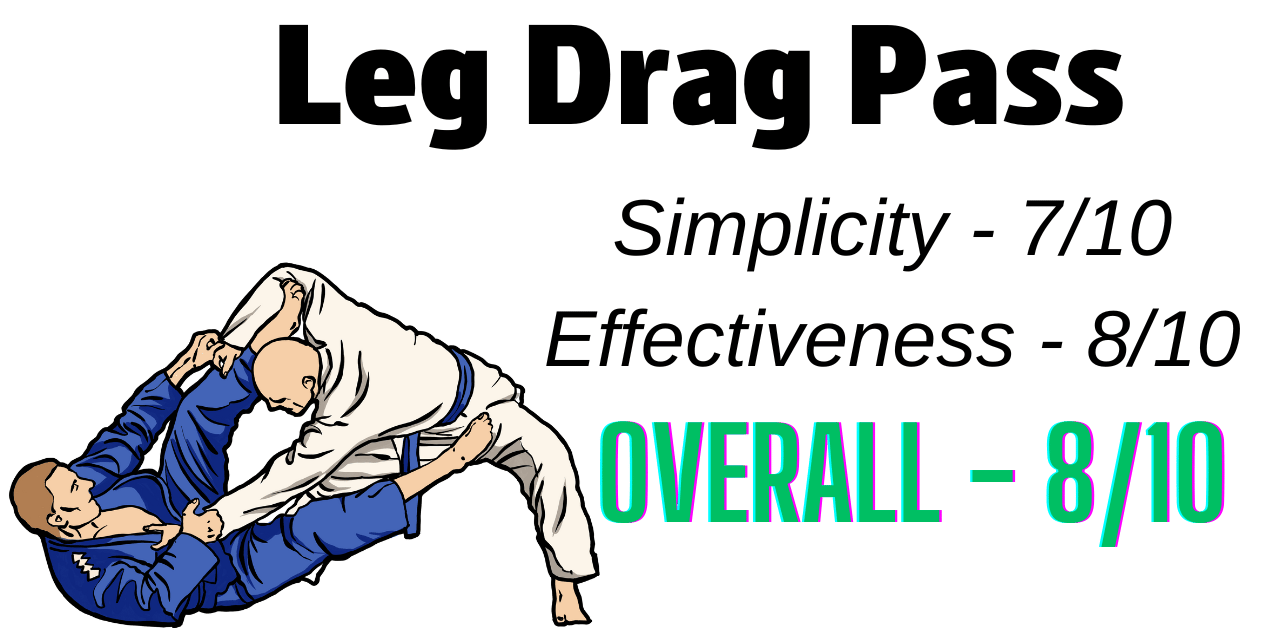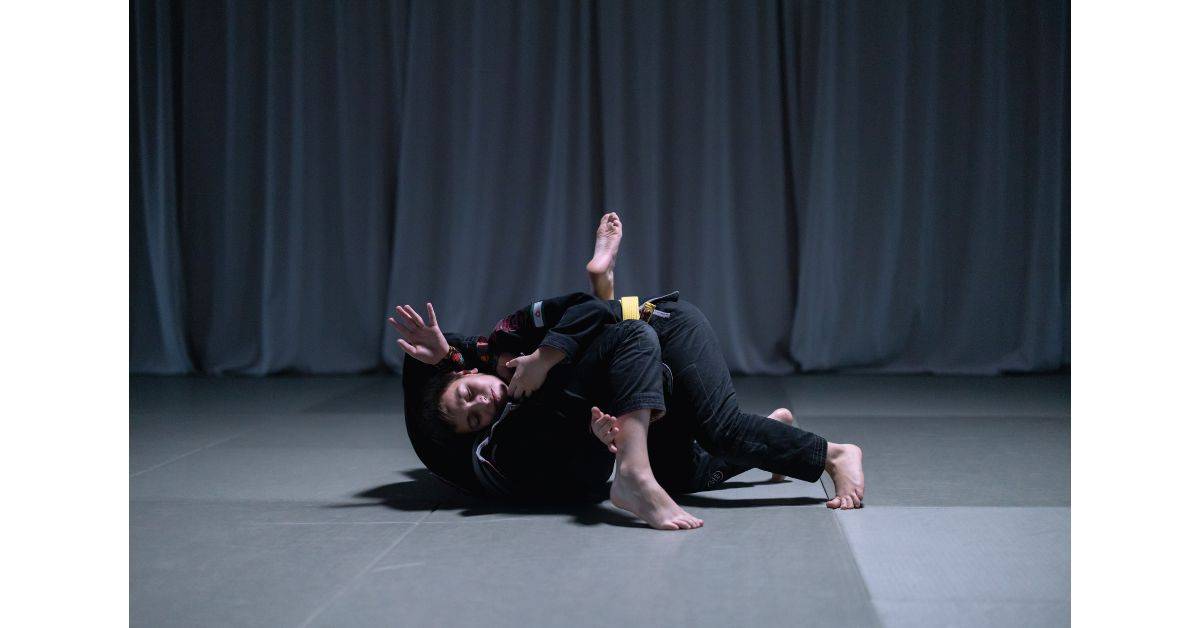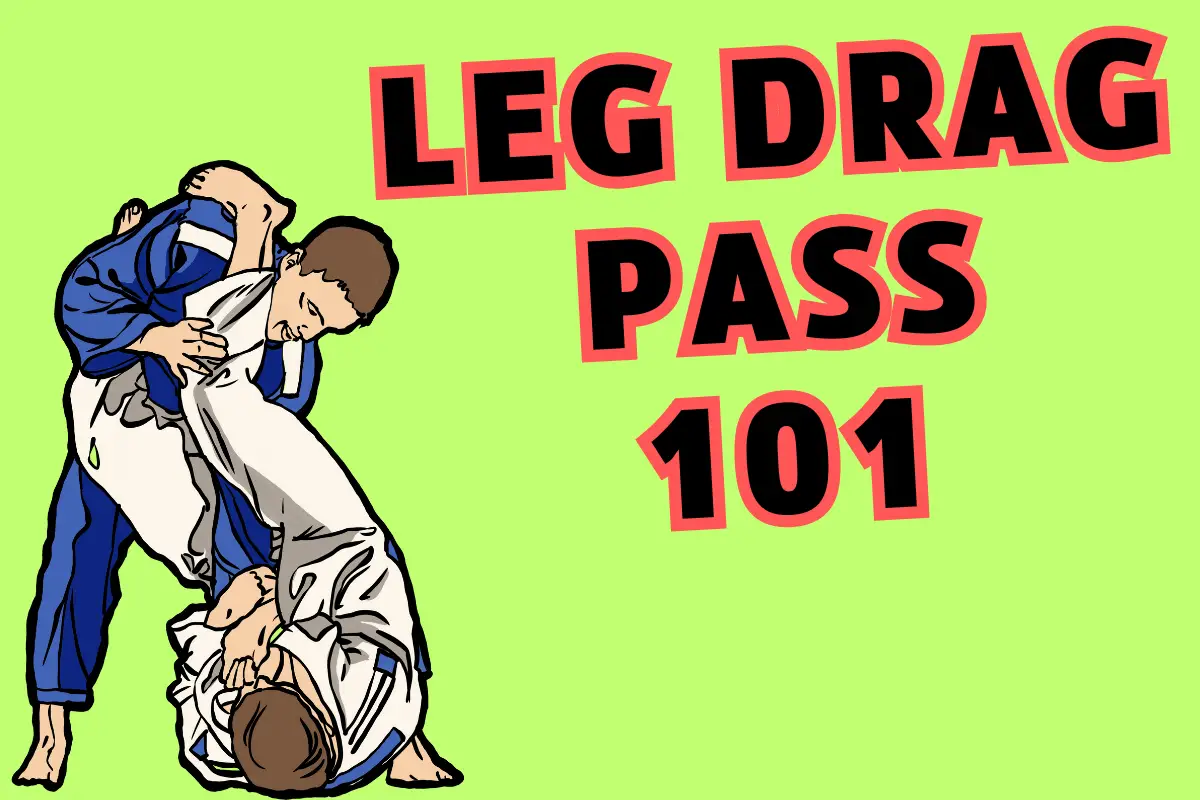The leg drag is perhaps the most critical guard pass in BJJ. You want to learn it as one of the first guard passes you begin to learn. If you just started out training, it’ll allow you to pass people’s guards easily and get your first few wins to your record.
To perform the leg drag pass, you must first begin by standing up with the opponent in an open guard position. Then you start by controlling his ankles and pulling one leg upward. You then move it to the side and maintain control over his hips. The last step is to take side control and finish with a submission.
Eventually, there are many variations of this guard pass you can learn and use to pass the opponent’s guard. First, however, this article will discuss what I believe is the simplest, most effective one.
Most white belts and advanced grapplers will repeatedly make the same mistakes. Now, these mistakes will prevent you from grabbing your first wins. So, you want to ensure you read this article as I break them down and give you straightforward solutions to them.
That’s why I recommend reading the entire article, even if there’s a section you think is simple; you still want to read it to learn the ninja tips that’ll help you win more rolls and get you your first wins.
So, let’s dive in.

How to perform the Leg Drag pass
Alright, let’s break down the steps to perform the leg drag pass quickly. Again, this is my favorite variation. You will likely learn a different variation of this guard pass if you attend BJJ classes. However, there’s always the chance you’ll learn the same variation.
But it’s not as likely.
Let me remind you that it’ll be best if you read each step and understand it as best as possible. Even if it sounds obvious, such as “start standing up,” you still want to read it, as it includes tips you don’t want to miss.
Enough introduction. Let’s dive into the first step!
Step #1 – Start by standing up
The first step is to start standing up. So, what can be complicated about that? Well, let me tell you exactly what mistakes many folks make that prevent them from passing the guard.
And yes, people can make mistakes right from the moment they stand up. However, the mistake most people make begins when their posture isn’t balanced.
You want your posture to be as balanced as possible. It can be quite detrimental if you lean forward or backward. Let’s assume you’re facing an advanced grappler; he can use your imbalanced posture to his advantage by making you fall forward or going for a submission from his closed-guard position.
That’s why you must stay balanced to ensure you can advance to step #2 without further worries.
So, now that your posture is balanced, you’re ready to advance to the next step.
Step #2 – Push one of the opponent’s knees downward
Now that your posture is solid, you want to push the opponent’s leg downward. You’ll be pushing the leg that you’re not targeting. So, if you’re going from the right side, push the left leg downward.
Why is this beneficial? Although not necessary for the leg drag pass, it’s critical that you create space between the legs, so the opponent will not be able to maneuver himself to you again.
It’ll help you have more time to work until the opponent realizes you’re performing this pass.
One of the variations we’ll discuss in one of the following few sections of this article will be simpler than this one, as it won’t include this step. However, it’ll work less often. Thus, you want to push the knee of the leg you’re not targeting downward.
Step #3 – Grab the other leg and pull it upward
The 3rd step, which you can do with the 2nd step simultaneously, is to grab the other leg and pull it upward (toward your chest.)
If you push one leg down and the other toward you, the opponent will find it difficult to react quickly. Therefore, you’ll be more likely to pass his guard and get the win.
Another ninja tip is to leave your back foot far back and not have it close to the opponent’s hips. If your back foot is close to his hips, he can grab it, making you imbalanced. And you don’t want that to happen.
Step #4 – Drag the leg and move it to the side
The next step will be to drag the leg you gripped in the 3rd step and move it to the side. Again, it would be best if you had already lifted it up by this point. Now, you want to grip it firmly and move it to the side.
That is the first part of the leg drag. You’ll notice how the opponent’s body shifts in one direction by this point. This is because you want to use the opponent’s body momentum and leverage it to your advantage. So, you can probably guess where this is going.
Now that you dragged one leg of the opponent to the side of the other, you can advance to the following step.
Step #5 – Take control of the opponent’s hips
The 5th step is to take control of the opponent’s hips. If you’ve been grappling for over a few months, you know how critical it is to control the opponent’s hips and head. However, the hips can be more important sometimes.
In our case, you must control the opponent’s hips before gaining side control.
Although you’re already past the opponent’s guard at this point, you want to attain more authority by controlling the opponent’s hips.
How do you do that? You only need to grip his hips and block his knee down. He won’t be able to roll to either side and escape your current position because of your control. So maintain it before moving to the next step.
Step #6 – Grab the other leg and pull it toward you
Now for the final step before you gain side control and finish the move. Remember, you have dragged his leg to one side and got hip control. What you want to do now is this:
You want to grab the other leg (preferably the knee) and pull it toward you. That will allow you to transition to the last step of your move, side control.
Step #7 – Gain side control
Now that you have pulled his leg toward you. You can more easily transition to the side control. Again, the motion should be swift. If you hesitate, the opponent will likely escape your hold and attack you. But, of course, you don’t want that.
Instead, gain side control when you pull his other knee toward you. From here, your options are pretty much endless. However, I still want to give you a few tips on finishing your move and winning the fight after you use the leg drag pass.
Let’s dive into the 8th step.
Step #8 – Finish the move
You have passed the opponent’s guard in the 5th step to understanding the pass better. Now, you want to finish the move using any submission you like.
Once you have side control, I recommend you go for the Kimura. It’s actually my favorite submission to transition into when I have side control. You can easily trap the arm, get the Kimura grip, and start attacking. Follow the link if you want to learn how to perform the Kimura flawlessly.
Another submission you can go for is the Guillotine choke from side control. You can even get back-control and go for the rear naked choke. Likewise, you can go for the straight arm lock or Armbar.
Really, you want to become as creative as possible and be as unexpected as possible. That alone will skyrocket your winning chances.
If you want to learn about another highly effective pass, I wrote a complete guide about the Knee Slice (Cut) Pass, and I recommend you give it a read to become a much better grappler.
Best finishing submission after the Leg Drag pass
After you finish doing the leg drag pass, you probably want to finish the fight by going for a submission from side control. But, really, your options are endless. The critical part here is to go for any submission, even if it’s not the best choice, before the opponent escapes your side control and starts returning fire.
The Kimura is the best finishing submission after the leg drag pass since you have side control. However, you can go for any submission and win the fight if you’ve trained it before. For example, you can also go for the Triangle choke, which can also be effective from side control.

Your options are endless! You can go for any move if you remain unexpected and know what you’re doing. It’ll be best if you don’t start making up random moves to go for. Instead, stick with what you know.
Variations of the Leg Drag pass
This part of the article will focus on two variations of the leg drag pass. The first will be what we’ve discussed thus far, and the second will be a less complicated and technical version.
These don’t have names, so I made up names; I hope you find this part helpful.
You can use either one you prefer, but I recommend learning the technical one, as it’s more effective.
If you want to learn about the Toreando pass and what makes it one of BJJ’s most effective guard passes, follow the link.
Technical Leg Drag
The first one we’ll discuss is the technical leg drag. I’ll keep it short, as the entire article has examined it already.
What makes this variation unique is the pulling upward motion. Realistically speaking, you can’t pull the opponent’s leg to the side without first pulling it upward, as he’ll resist the transition. So, you do all the steps I’ve presented in this article and ensure to pull his leg upward before dragging it to the side.
This variation is more likely to succeed, so make sure to learn it!
Quick Leg Drag
The quick leg drag is a variation that utilizes quick motions. You’ll skip steps #6, 5, and 3. Or, you’ll drag the opponent’s leg to the side as quickly as possible. And you’ll transition to side control right after doing so.
The quick leg drag is less effective and can be used effectively against the lower leagues in BJJ. So while it might surprise some advanced grapplers, I recommend sticking with the technical approach.
And yet, you can learn whichever one you prefer! So try them both and see which sticks.
Follow the link if you want to perform the Stack Pass in BJJ perfectly.
When should I use the Leg Drag pass?
It would be best if you use the leg drag pass when you control the opponent’s legs. Although you might need to fight over this position, you can perform this guard pass flawlessly once you’re there.
If you want to learn another excellent pass, follow the link to start practicing the X pass and win more fights using it.
Is the Leg Drag pass effective?
The Leg Drag pass is one of BJJ’s most effective guard passes. It allows you to gain control over the opponent’s hips and legs to attain side control eventually. Then, you can advance from side control to any submission you’d like, such as the Kimura, Armbar, Guillotine, and straight arm lock.
The Cartwheel pass is another highly effective pass you can use to win more fights by gaining side control. Follow the link to learn to execute it without any mistakes.
Should I learn the Leg Drag pass?
Learning the leg drag pass is necessary if you want to call yourself a solid grappler. It allows you to gain control over the opponent’s hips, allowing you the advantage in the fight. After you do the leg drag, you can finish the fight by going to a finishing submission and coming out victorious.
Final words
This article was a blast to write. I’m a big fan of the leg drag pass, and I’m confident it can help you win your first few fights (if you’re a novice grappler.)
This website is entirely about martial arts and how to improve yourself with them. So if that’s something that is of interest to you, ensure to keep up with the latest articles.
The leg drag is one of BJJ’s most important and effective guard passes.
However, the leg drag pass isn’t the most effective one. So, I wrote an article reviewing the best guard passes that you must learn to call yourself a solid grappler. So, follow the link to learn more.

